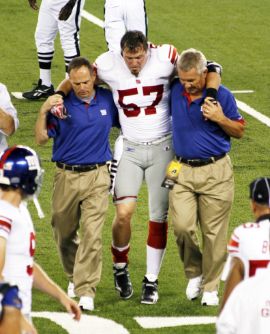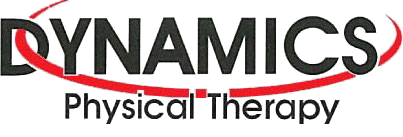 Sports-related injuries can occur during indoor and outdoor sports, as well as while training or regularly exercising. These types of injuries may be the result of improper training techniques, overtraining, the misuse of equipment or protective devices, an inadequate warm-up, poorly performed stretching exercises, or an unforeseen accident. The most common sports-related injuries include: strains, sprains, dislocations, and fractures. The feet, ankles, shoulders, hips, and knees are most frequently injured during sports activities.
Sports-related injuries can occur during indoor and outdoor sports, as well as while training or regularly exercising. These types of injuries may be the result of improper training techniques, overtraining, the misuse of equipment or protective devices, an inadequate warm-up, poorly performed stretching exercises, or an unforeseen accident. The most common sports-related injuries include: strains, sprains, dislocations, and fractures. The feet, ankles, shoulders, hips, and knees are most frequently injured during sports activities.
A well-known approach for immediate injury management is rest, ice, compression and elevation (RICE). New research is emerging examining the use of ice in acute injury and suggests that ice may slow down the inflammatory response necessary in the first 48 hours after an acute injury to initiate healing.
As recovery progresses, ice may be better used after the first 48 hours to help to reduce any secondary tissue damage that occurs from persistent swelling and chemical irritation from blood and tissue fluid in the area.
Some researchers are suggesting taking a POLICE approach P - Protect, OL - Optimally Load I - Ice C - Compress and E - Elevate. This approach focuses on early loading to stimulate tissue recovery and maintain good blood supply and limit excessive swelling after an acute injury which could delay your recovery.
Protection: A period of relative rest from your sport or activity may be necessary to allow tissues to heal and prevent further injury, but complete rest is not recommended. Early motion and loading however can feel unsteady or painful so using tape, crutches, or braces can improve joint proprioception (your body’s awareness of where it is in space), your confidence, AND help reduce pain.
Optimum Loading: While in the protection phase of the first few hours to days after an injury, you want to gently move the limb or joints that are hurt. This may mean standing with less than 50% of your weight on a sprained ankle, drawing the alphabet with your foot while sitting. Or, after shoulder surgery, you might start moving the hand and wrist and progress to the elbow and shoulder as your pain allows. For less severe injuries like a mild sprain of a knee ligament, this might mean doing squats without extra weight or riding a stationary bike but not doing hopping drills.
Ice: After the first 48 hours, applying ice for 10-15 minutes a few times per day may help to manage the excess swelling around your injured muscle or joint, and ice can help decrease some of the acute pain that you may be experiencing. Consulting a physical therapist is the best way to determine if the use of ice is necessary or appropriate for your injury.
Compression: While practicing early movement and loading, or during a relative rest period with icing, adding compression in the form of a tensor bandage or compression sleeve helps to manage swelling, improve joint position awareness, and reduce pain. Talk to your physical therapist about the best way to add compression for your injury, and ensure that it’s done safely to limit the risk of loss of circulation.
Elevation: Elevation is simple for some body parts. You can easily prop up an injured ankle or knee on a stack of pillows while you are lying down. An injury to your elbow or wrist requires that you elevate your entire arm on something. Your physical therapist can help advise you on the best way to elevate your injury.
Research shows that the combination of appropriate early management (i.e. POLICE) and joint mobilization or manual therapy techniques (that are typically performed by a physical therapist) greatly improve the range of movement in injured areas, especially injured joints. This leads to quicker recovery periods, shorter sick leave, and a faster return to sports participation.
Non-steroidal anti-inflammatory drugs (NSAIDs) such as ibuprofen and aspirin are also frequently used to manage the pain and inflammation that is associated with sports injuries. Although NSAID use is recommended with caution, it often becomes necessary to facilitate early mobilization following an injury as it targets pain and discomfort that accompanies movement. When in doubt, it is best to speak with a physician or pharmacist who can make a useful recommendation regarding the use of NSAIDs for injury management purposes. Taking NSAIDs for short periods following an injury is often beneficial, but requiring this type of medication for long periods of time – in order to experience pain relief and mobility – indicates an ongoing problem that needs to be addressed by a professional such as a physical therapist who can help you with medication-free options for getting back on track .
If you have recently been injured while playing a sport or you’re experiencing discomfort due to an old injury, it may be time to schedule a consultation with a physical therapist. According to research, recovery is quicker and people tend to return to their favorite sport sooner if they receive physical therapy and incorporate early management and mobility of acute injuries.
Some sports-related injuries can have devastating, long-lasting effects while others are minor, but bothersome nonetheless. Physical therapists can help you balance the right amount of movement and rest in order to improve your recovery and prevent further injury. In addition, they have the skills and training to help individuals with different types of injuries by designing management approaches that are individualized to meet their clients’ needs.
References
1. Avery DM, Rodner CM, Edgar CM. Sports-related wrist and hand injuries: a review. J Orthop Surg Res. 2016;11(1):99.
2. van den Bekerom MP, Struijs PA, Blankevoort L, et al. What is the evidence for rest, ice, compression, and elevation therapy in the treatment of ankle sprains in adults? J Athl Train. 2012;47(4):435-43.
3. Bleakley CM et al. Effect of accelerated rehabilitation on function after ankle sprain: randomized controlled trial. BMJ 2010 May 10;340:c1964
4. Bleakley CM, Glasgow P, MacAuley DC. PRICE needs updating, should we call the POLICE? Br J Sports Med. 2012 Mar;46(4):220-1.
5. Green T, Refshauge K, Crosbie J, Adams R. A randomized controlled trial of a passive accessory joint mobilization on acute ankle inversion sprains. Phys Ther. 2001;81(4):984-94.
6. Karlsson J, Eriksson BI, Swärd L. Early functional treatment for acute ligament injuries of the ankle joint. Scand J Med Sci Sports. 1996;6(6):341-5.
7. Paoloni JA, Milne C, Orchard J, Hamilton B. Non-steroidal anti-inflammatory drugs in sports medicine: guidelines for practical but sensible use. Br J Sports Med. 2009;43(11):863-5.
8. Drezner J. Practical management: hamstring muscle injuries. Clin J Sport Med 2003;13(1):48-52.


